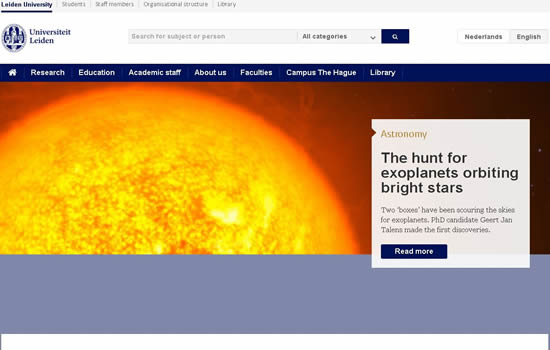选择热点
 荷兰莱顿大学
荷兰莱顿大学 西班牙巴塞罗那大学
西班牙巴塞罗那大学 巴西圣保罗大学 University of Sao Paulo, Brazil
巴西圣保罗大学 University of Sao Paulo, Brazil 台湾南华大学 University of South China in Taiwan
台湾南华大学 University of South China in Taiwan 科技大学 National University of Defense Technology
科技大学 National University of Defense Technology 南京大学 Nanjing University
南京大学 Nanjing University 上海复旦大学 Fudan University
上海复旦大学 Fudan University 泗水大学(Ubaya)
泗水大学(Ubaya) 印尼大学 universitas indonesia
印尼大学 universitas indonesia 越南某大学 Vietnam National University
越南某大学 Vietnam National University 菲律宾大学 University Of The Philippines
菲律宾大学 University Of The Philippines
Thousands Dazzled by Solar Eclipse!
发布时间:2025-01-06
来源:大学网站
December 7—Much of the southern half of the world saw one of nature's hottest shows earlier this week.
Day became night for a few short minutes in southern Africa and Australia on Wednesday, as a solar eclipse brought darkness to these parts of the world.
"Solar eclipses are spectacular to watch because of the drama of the sky going dark in the daytime, the blue sky going away, and the rapid changes in the sun," said Jay Pasachoff, an astronomer from Williams College in Massachusetts.
Although the sun is almost completely blocked out during an eclipse, viewers must never look at the eclipse directly without special eclipse-viewing glasses.
Looking directly at the sun can permanently damage your eyes.
A solar eclipse occurs when the moon passes between the Earth and the sun, blocking out all of the sun but its corona, or outer ring.
Solar eclipses are possible only because the sun and the moon appear to be about the same size in the sky.
This is a real photo of tourists watching the solar eclipse in the town of Lyndhurst, Australia.
(REUTERS/David Gray) According to astronomers, or scientists who study space, the sun is about 400 times bigger than the moon, but it is also about 400 times further from the Earth than the moon.
Total eclipses happen about every one and a half years.
The last one took place on June 21, 2001.
The solar eclipse was an exciting experience for people in both Africa and Australia.
Thousands watched and cheered as the eclipse's path crossed the African countries of Angola, Zambia, Zimbabwe, South Africa, and Mozambique.
"There, that's magic," said Cherry Hochfelden of Johannesburg, South Africa, as the sky turned dark.
After traveling across southern Africa, the eclipse crossed the Indian Ocean to Australia, where some 20,000 spectators were awaiting its arrival in the small town of Ceduna.
Ceduna was one of only two Australian towns in the direct path of the total eclipse.
"It was the most amazing 30 seconds of my life.
It was a shining white, purple ring," said Ivan Blajer, who traveled more than a 1,000 miles to watch the eclipse.
译文: 几千人被日蚀耀花眼 --劳拉·林供稿 12月7日—大部分南半球的人这个周的早些时候看到了大自然的最热烈的表演。
星期三在南非洲和澳大利亚白天变成了夜晚,日蚀将黑暗带到这部分世界。
日蚀是引人入胜的景观,因为天空戏剧性地变黑了,蓝天隐去了,太阳迅速地变化了,”洁·帕萨夫,一个来自马萨诸塞威廉大学的天文学家说。
日蚀时虽然太阳几乎全部被挡住了,观看者还不能直接在没有日蚀观望镜的情况下直视日蚀。
直接地看太阳可能会永久地伤害你的眼睛。
日蚀是在月亮穿过太阳和地球之间时发生,挡住全部的太阳只留下光环或外环。
日蚀的产生是当太阳和月亮在天空中看起来几乎一样大时才可能。
根据天文学家或者研究宇宙的科学家说,太阳大概是月亮的400倍大,但是也几乎是离地球的400倍距离远。
日全蚀每一年半发生一次。
上一次产生是在2001年6月。
日蚀对于非洲和澳大利亚的人来说是一次激动人心的经历。
当日蚀的路径通过非洲的国家安哥拉、赞比亚、津巴布韦、南非和莫桑比克时几千人观看和欢呼。
真是不可思议,”当天空变暗时,南非约翰内斯堡的切里·浩切费登说。
当穿过南部非洲后,日蚀穿过印度洋到达澳大利亚,在那儿塞度纳小镇两万人已经在等待着它的到来。
塞度纳是澳大利亚的仅有的两个出现日全蚀的小镇。
那是最令人惊异的30秒。
那时耀眼的白色、紫色的环,”伊凡·布雷说。
他走了1000英里来看日蚀。
【Thousands Dazzled by Solar Eclipse!查看网站:[db:时间]】
Day became night for a few short minutes in southern Africa and Australia on Wednesday, as a solar eclipse brought darkness to these parts of the world.
"Solar eclipses are spectacular to watch because of the drama of the sky going dark in the daytime, the blue sky going away, and the rapid changes in the sun," said Jay Pasachoff, an astronomer from Williams College in Massachusetts.
Although the sun is almost completely blocked out during an eclipse, viewers must never look at the eclipse directly without special eclipse-viewing glasses.
Looking directly at the sun can permanently damage your eyes.
A solar eclipse occurs when the moon passes between the Earth and the sun, blocking out all of the sun but its corona, or outer ring.
Solar eclipses are possible only because the sun and the moon appear to be about the same size in the sky.
This is a real photo of tourists watching the solar eclipse in the town of Lyndhurst, Australia.
(REUTERS/David Gray) According to astronomers, or scientists who study space, the sun is about 400 times bigger than the moon, but it is also about 400 times further from the Earth than the moon.
Total eclipses happen about every one and a half years.
The last one took place on June 21, 2001.
The solar eclipse was an exciting experience for people in both Africa and Australia.
Thousands watched and cheered as the eclipse's path crossed the African countries of Angola, Zambia, Zimbabwe, South Africa, and Mozambique.
"There, that's magic," said Cherry Hochfelden of Johannesburg, South Africa, as the sky turned dark.
After traveling across southern Africa, the eclipse crossed the Indian Ocean to Australia, where some 20,000 spectators were awaiting its arrival in the small town of Ceduna.
Ceduna was one of only two Australian towns in the direct path of the total eclipse.
"It was the most amazing 30 seconds of my life.
It was a shining white, purple ring," said Ivan Blajer, who traveled more than a 1,000 miles to watch the eclipse.
译文: 几千人被日蚀耀花眼 --劳拉·林供稿 12月7日—大部分南半球的人这个周的早些时候看到了大自然的最热烈的表演。
星期三在南非洲和澳大利亚白天变成了夜晚,日蚀将黑暗带到这部分世界。
日蚀是引人入胜的景观,因为天空戏剧性地变黑了,蓝天隐去了,太阳迅速地变化了,”洁·帕萨夫,一个来自马萨诸塞威廉大学的天文学家说。
日蚀时虽然太阳几乎全部被挡住了,观看者还不能直接在没有日蚀观望镜的情况下直视日蚀。
直接地看太阳可能会永久地伤害你的眼睛。
日蚀是在月亮穿过太阳和地球之间时发生,挡住全部的太阳只留下光环或外环。
日蚀的产生是当太阳和月亮在天空中看起来几乎一样大时才可能。
根据天文学家或者研究宇宙的科学家说,太阳大概是月亮的400倍大,但是也几乎是离地球的400倍距离远。
日全蚀每一年半发生一次。
上一次产生是在2001年6月。
日蚀对于非洲和澳大利亚的人来说是一次激动人心的经历。
当日蚀的路径通过非洲的国家安哥拉、赞比亚、津巴布韦、南非和莫桑比克时几千人观看和欢呼。
真是不可思议,”当天空变暗时,南非约翰内斯堡的切里·浩切费登说。
当穿过南部非洲后,日蚀穿过印度洋到达澳大利亚,在那儿塞度纳小镇两万人已经在等待着它的到来。
塞度纳是澳大利亚的仅有的两个出现日全蚀的小镇。
那是最令人惊异的30秒。
那时耀眼的白色、紫色的环,”伊凡·布雷说。
他走了1000英里来看日蚀。
【Thousands Dazzled by Solar Eclipse!查看网站:[db:时间]】
相关阅读
目录列表
资讯列表
英语资讯


共0条评论
网友评论温馨提示:您的评论需要经过审核才能显示,请文明发言!